Scientific happenings, big and small, on this day in history
But first: today’s quiz. What inventor, who died on this day in 1902, developed and patented a highly popular (and much beloved) item of clothing in 1873? Trust me, you most likely have this item of clothing in your wardrobe, and in fact may be wearing it right now – especially since it’s Friday. The answer can be found at the end of this article.
On to other historic happenings…
EVENTS
1580
Francis Drake completes his circumnavigation of the world
Late in 1577, Francis Drake left England with five ships, supposedly on a trading expedition to the Nile. On reaching Africa, the true destination was revealed to be the Pacific Ocean via the Strait of Magellan, (much to the dismay of some of the sailors that were accompanying him who were not anticipating such a lengthy journey).
By late 1578, after experiencing massive storms at sea and dissention among some of his crew; he had been deserted by one ship, had lost another in a storm, and had to break up the other two as unseaworthy. However, Drake continued on his journey with his one remaining ship, the Golden Hind.
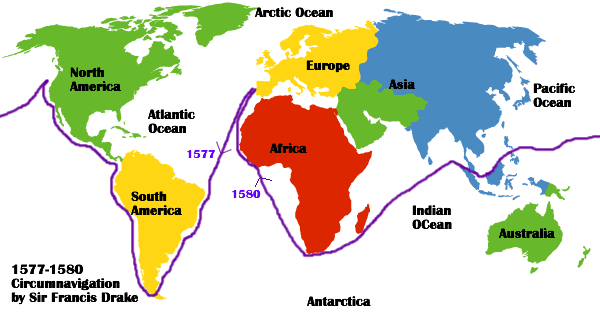
Drake sailed north from the Strait of Magellan along the Pacific South American coast into the previously undisturbed private waters of King Philip of Spain. The first stop, for food and water, was at the (now) Chilean Island of Mocha, where the rebellious residents laid a nearly disastrous ambush, having mistaken the English for their Spanish oppressors.
After this bad beginning in the Pacific the tide turned, and for the next five and a half months Drake raided Spanish settlements at will, among them Valpariso, Lima and Arica, and easily took Spanish ships, including the rich treasure ship Cacafuego, leaving panic, chaos, and a confused pursuit in his wake. During this time, he captured and released a number of Europeans, whose subsequent testimony survives. The plundering was remarkable for its restraint; neither the Spanish nor the natives were intentionally harmed, there was very little violence, and there were very few casualties. Drake's crew in the Pacific was of unknown number, with estimates ranging from around sixty to one hundred men.
Drake cruised north as far as San Francisco. Then, thinking it safer not to return by the Straits, he struck out across the Pacific without a chart or pilot. The crossing was uneventful, and landfall was made in sixty eight days.
The next months Drake spent sailing about in the Indonesian archipelago, making promising commercial contacts, local political alliances and trading for spices. Difficulty in finding a route through the thousands of islands nearly ended the journey in January of 1580, when the Golden Hind ran hard onto a reef in apparent open water; but after several desperate days a change of wind freed the ship
Continuing westward, the Golden Hind crossed the Indian Ocean without incident, rounded the Cape of Good Hope into the Atlantic, sailed up the coast of Africa, and arrived triumphantly in England on September 26, 1580 -- with nearly three years and some 36,000 miles having past since his departure.
Source:
Francis Drake the Voyage
1956
First new U.S. Interstate Highway paved
In 1956, the first new concrete road surface to be paved as part of the U.S. Interstate Highway System following the signing of the Federal-Aid Highway Act of 1956 was poured in Kansas for an 8-mile, two-lane section of U.S. 40 which became Interstate 70, a few miles west of Topeka.
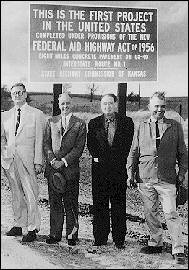
The construction was under way before the enactment of the Federal-Aid Highway Act of 1956, but paving under the new contract began on Sept. 26. Because this was the first paving to be initiated after the 1956 act, First District State Highway Commissioner Ivan Wassberg wrote "9-26-56" in the fresh cement to mark the historic day. On Nov. 14, Gov. Fred Hall participated in a ribbon-cutting to open the newly paved road, and a sign was posted, identifying this section of I-70 as the "first project in the United States completed under the provisions of the new Federal-Aid Highway Act of 1956."
Source:
Three States Claim First Interstate Highway
1960
The first televised debate takes place between presidential candidates Richard M. Nixon and John F. Kennedy.
In 1960 at the Republican Convention, Nixon had pledged to campaign in all fifty states. This pledge backfired when, in August, Nixon injured his knee on a car door while campaigning in North Carolina; the knee became infected and Nixon had to cease campaigning for two weeks while the infected knee was injected with antibiotics. When he left Walter Reed Hospital, Nixon refused to abandon his pledge to visit every state. He therefore wound up wasting valuable time visiting states that he had no chance to win, or which had few electoral votes and would be of little help in the election. For example, in his effort to visit all fifty states -- Nixon spent the vital weekend before the election campaigning in Alaska, which had only three electoral votes; while Kennedy campaigned in large states such as New Jersey, Ohio, Michigan, and Pennsylvania.
But the key turning point of the campaign was the four Kennedy-Nixon debates; they were the first presidential debates held on television. Nixon insisted on campaigning until just a few hours before the first debate started on September 26, 1960. He had not completely recovered from his hospital stay and thus looked pale, sickly, underweight, and tired. He also refused makeup for the first debate, claiming it was not masculine enough, and as a result his beard stubble showed prominently on the era's black-and-white TV screens. Nixon's poor appearance on television in the first debate is reflected by the fact that his mother called him immediately following the debate to ask if he was sick. Kennedy, by contrast, rested before the first debate and appeared tanned, confident, and relaxed during the debate.
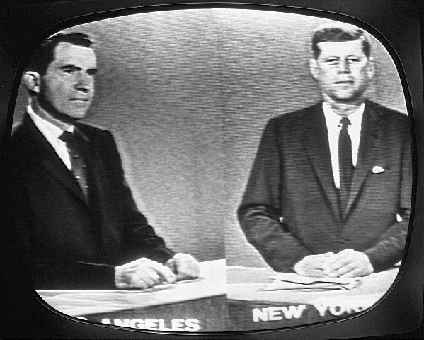
An estimated 80 million viewers watched the first debate. Most people who watched the debate on TV believed Kennedy had won while radio listeners (a smaller audience) believed Nixon had won. After it had ended polls showed Kennedy moving from a slight deficit into a slight lead over Nixon. For the remaining three debates Nixon regained his lost weight, wore television makeup, and appeared more forceful than his initial appearance. Political observers of the time believed that Kennedy won the first debate, Nixon won the second and third debates, and that the fourth debate, which was seen as the strongest performance by both men, was a draw.
The resulting election on November 8 remains one of the most famous election nights in American history. As the early returns poured in from large Northern and Midwestern cities such as Boston, New York City, Buffalo, Philadelphia, Pittsburgh, Baltimore, Detroit, and Chicago, Kennedy opened a large lead in the popular and electoral vote, and appeared headed for victory. However, as later returns came in from the Western states and rural and suburban areas in the Midwest, Nixon began to steadily close the gap with Kennedy. It was not until the afternoon of Wednesday, November 9 that Nixon finally conceded the election and Kennedy claimed victory – but with such a tight race, it is still debated about what impact the televised debates may have had on the outcome of the election.
1973
Concorde makes its first non-stop crossing of the Atlantic in record-breaking time
In the late 1950s, the United Kingdom, France, United States and Soviet Union were considering developing supersonic transport. Britain's Bristol Aeroplane Company and France's Sud Aviation were both working on designs largely funded by their respective governments. The British design was for a thin-winged delta shape for a transatlantic-ranged aircraft for about 100 people, while the French were intending to build a medium-range aircraft.
The designs were both ready to start prototype construction in the early 1960s, but the cost was so great that the British government made it a requirement that BAC look for international co-operation. Approaches were made to a number of countries, but only France showed real interest. The development project was negotiated as an international treaty between the two countries rather than a commercial agreement between companies and included a clause, originally asked for by Britain, imposing heavy penalties for cancellation. A draft treaty was signed on 28 November 1962. By this time, both companies had been merged into new ones; thus, the Concorde project was between the British Aircraft Corp. and Aerospatiale.
Construction of two prototypes began in February 1965: 001, built by Aerospatiale, and 002, by BAC. Concorde 001 made its first test flight on 2 March 1969 and first went supersonic on 1 October. The first UK-built Concorde flew on 9 April 1969.
Concorde was an ogive delta-winged ("OG delta wing") aircraft with four Olympus engines based on those originally developed for the Avro Vulcan strategic bomber. Concorde was the first civil airliner to have an analogue fly-by-wire flight control system. It also employed a trademark droop snoot lowering nose section for visibility on approach. These and other features permitted Concorde to have an average cruise speed of Mach 2.02 (approximately 1,330 mph) with a maximum cruise altitude of 60,000 feet, more than twice the speed of conventional aircraft. The average landing speed was a relatively high 185 mph.
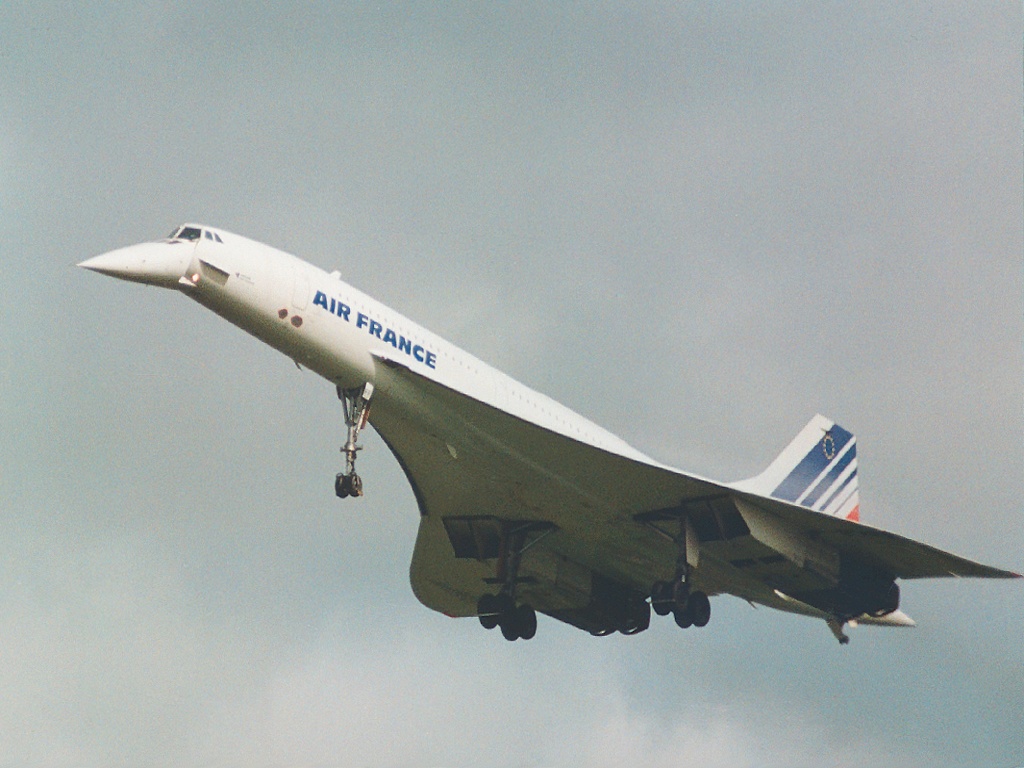
On September 26, 1973, the French model of the supersonic airliner flew from the US capital, Washington, to Orly airport in Paris in three hours 32 minutes. The pilots, Jean Franchi and Gilbert Defer, cut the previous record for a transatlantic airliner journey in half. Officials for Aerospatiale - the French company involved in the project - said the plane touched down at 1617 local time (1517 GMT), 13 minutes ahead of schedule.
Concorde began commercial flights in January 1976 with London-Bahrain and Paris-Rio services. Regular flights to the US did not start for another three years as American aviation authorities were not willing to allow the plane to land at their airports.
Concorde had an almost unblemished safety record until 25 July 2000, when an Air France model built in 1975 crashed shortly after taking off from Charles de Gaulle Airport in Paris. All 109 people on board were killed and there were also four fatalities on the ground. All Concordes were grounded while a full investigation took place.
According to the official investigation conducted by the French accident investigation bureau (BEA), the crash was caused by a titanium strip, part of a thrust reverser, that fell from a Continental Airlines DC-10 that had taken off about four minutes earlier. This metal fragment punctured a tire on the left main wheel bogie. The tire exploded, and a piece of rubber hit the fuel tank and broke an electrical cable. The impact caused a hydrodynamic shockwave that fractured the fuel tank some distance from the point of impact. This caused a major fuel leak from the tank, which then ignited due to severed electrical wires which were sparking. The crew shut down engine number 2 in response to a fire warning, but were unable to retract the landing gear -- hampering the aircraft's climb. With engine number 1 surging and producing little power, the aircraft was unable to gain height or speed, entering a rapid pitch-up then a violent descent, rolling left. The impact occurred with the stricken aircraft tail-low, crashing into the Hotelissimo Hotel in Gonesse. The accident subsequently led to a program of modifications, including more secure electrical controls, Kevlar lining to the fuel tanks and specially-developed burst-resistant tires.
The first test flight after the modifications departed from London Heathrow on 17 July 2001. During the 3:20 hr flight over the mid-Atlantic towards Iceland, the plane attained Mach 2.02 and 60,000 ft. The test flight, intended to resemble the London-New York route, was declared a success and was watched on live TV, and by crowds on the ground at both locations.
The first BA passenger flight took place on 11 September 2001, and was in the air during the September 11, 2001 attacks in the United States. This was not a revenue flight, as all the passengers were BA employees.
Normal commercial operations resumed on 7 November 2001, however In April 2003 British Airways and Air France announced the plane would be retired due to low passenger numbers following the 25 July 2000 crash, the slump in air travel following the September 11 attacks, and rising maintenance costs. Concorde's final commercial flight was on 23 October 2003.
No commercial supersonic aircraft are currently in service to continue the market once served by the Concorde. However, a new private supersonic jet designed for domestic travel is currently in development in Texas.
1991
Four men and four women enter Biosphere 2 an airtight, self-contained structure in Oracle, Ariz., where they would live for two years. The 7,200,000-cu-ft sealed glass and space-frame structure contained 5 biomes, including a 900,000-gallon ocean, a rain forest, a desert, agricultural areas and a human habitat.
Constructed between 1987 and 1991, Biosphere 2 was used to explore the complex web of interactions within life systems. It also explored the possible use of closed biospheres in space colonization, and allowed the study and manipulation of a biosphere without harming Earth's. The name comes from the idea that it is modeled on the first biosphere, which is the life system on Earth.

At a size comparable to two and a half football fields, it was the largest closed system ever created. The sealed nature of the structure allowed scientists to monitor the ever-changing chemistry of the air, water and soil contained within. The health of the human crew was continuously monitored by a medical team.
Inside was a 1900 square meter rainforest, an 850 square meter ocean with a coral reef, a 450 square meter mangrove wetlands, a 1300 square meter savannah grassland, a 1400 square meter fog desert, a 2500 square meter agricultural system, a human habitat with living quarters and office, and a below-ground level technical facility. Heating and cooling water circulated through independent piping systems, and electrical power was supplied from a natural gas energy center through airtight penetrations.
The first closed mission lasted from September 26, 1991 to September 26, 1993.  The crew consisted of: medical doctor and researcher Roy Walford, Taber MacCallum, Mark Nelson, Sally Silverstone, Abigail Alling (a late replacement for Silke Schneider), Mark Van Thillo, Linda Leigh -- and our very own Scientific Blogging Featured Writer, Jayne Poynter.
The crew consisted of: medical doctor and researcher Roy Walford, Taber MacCallum, Mark Nelson, Sally Silverstone, Abigail Alling (a late replacement for Silke Schneider), Mark Van Thillo, Linda Leigh -- and our very own Scientific Blogging Featured Writer, Jayne Poynter.
By 2006, the structure was no longer maintained in an airtight state, and the property, which is in exurban Tucson, was slated to be redeveloped for a planned community.
As of June 5, 2007, the property including surrounding land, totaling 1650 acres, was sold to a residential home developer for US$50 million. A development including homes and a resort hotel was planned for a portion of the land. The Biosphere itself will remain open for tours.
On June 26, 2007, the University of Arizona announced that it would take over management of Biosphere 2, using the site as a laboratory to study climate change, among other things. The university will pay $100 per year to the owners of the 1,600-acre (6.5 km2) development in order to lease the 3.15 acres that contain Biosphere 2's structures. Original Biosphere financier Edward P. Bass has given the university an additional $30 million to maintain the site.
BIRTHS
1887
Sir Barnes Wallis (Born Sep 26 1887; Died Oct 30 1979)
Sir Barnes Wallis was a scientist and engineer, working mostly for Vickers-Armstrongs Aircraft. He designed the structure of the R.100 airship and the Vickers Wellesley and Wellington bombers, but is most famous for the "bouncing" bomb which was used by specially-formed 617 Squadron of the RAF to destroy the Möhne and Eder dams in Germany's Ruhr district in May 1943.
Even before the Second World War had begun, the Air Ministry and various individuals were investigating possible bombing targets within Germany. However, most targets were effectively protected by dispersal -- that is that they covered a wide area and it was thus difficult to destroy them completely. Wallis focused his thinking on destroying targets which could not be dispersed, "highly localized stores of energy in the form of coal, oil and water power", especially dams, and in particular the great dams of the Ruhr area (the Möhne, Sorpe, Eder and several others). These targets were particularly attractive for several reasons:
- they could not be moved, and their location was known
- great damage would be caused by the flow of water when the dam was broken
- massive flooding would be caused to mines, steelworks and other industries by the released water
- the loss of water would disrupt steel production and hydro-electric generation, as well as causing problems with supplies for canals and drinking
However, the problem posed was that the dams were so massive that the armaments of the time (mostly 500lb bombs) would simply not touch them.
Ongoing experiments on the amount of explosives needed to break a dam wall had found that while significant quantities (30,000lbs - 14 tons) were needed if the explosion was tens of feet away from the dam, as little as 6,500lbs (under 3 tons) would be sufficient if the explosion took place in contact with the wall.
Early in 1942, Wallis had the idea of "a missile" which would be dropped upstream of a dam, ricochet over the water in a series of bounces, and hit the dam - this offered two significant advantages: it would jump over anti-torpedo nets strung ahead of the dam wall, and would sink right up against the dam - the perfect location, as revealed by the earlier tests.
Persuaded by Wallis and films of the test drops, officials gave the go-ahead for further tests which led to the development of two separate variants of the "bouncing bomb" idea - a large cylindrical mine (codenamed Upkeep) to be carried by the new Lancaster for use against dams (Wallis was confident that if one mine could be dropped in the right place, a dam could be breached) and a smaller spherical mine (codenamed Highball) to be carried by Mosquitoes for use against capital ships.
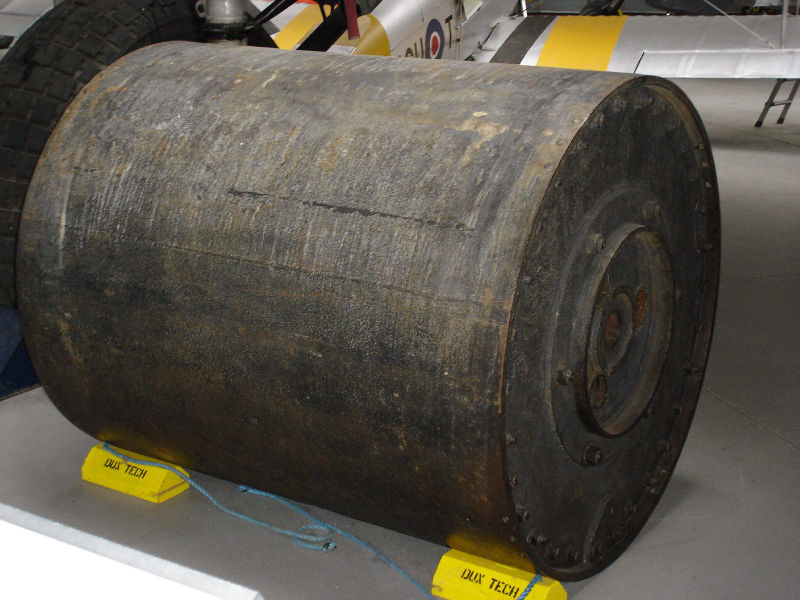
A variety of shapes, drop heights and backspin rotation speeds were tested. Upkeep proved satisfactory, although Highball was found to be less accurate after release.
By early 1943, the best time to hit the dams (when they were full after the Spring rains) was approaching, and on 26th February it was decided to mount a dams raid using Upkeep (Highball development continued but was scaled down). Twenty-three Lancasters were modified to carry the Upkeep mine, and 617 Squadron was formed to perform the mission. On 16th May 1943 (the night of a full moon), 19 Lancasters of 617 Squadron under Wing Commander Guy Gibson took off from RAF Scampton (Lincolnshire) in three waves to attack the Möhne, Eder and Sorpe Dams.
The result of Operation Chastise, its impact on the war and its cost in terms of lost aircraft and men (out of 19 aircraft, 8 were lost and 53 of the 56 crew in those aircraft were killed) has been the subject of much controversy. Typical Bomber Command raids of the time were experiencing losses around 5% of aircraft dispatched, often not hitting their targets, and Operation Chastise was well above this. However, its losses were not directly attributable to Upkeep (only one aircraft was lost in the actual dams attacks), but more to the low-level approach and bad luck. The propaganda benefits to Britain, and the corresponding damage to morale in Germany, were not insignificant.
It is clear, however, that the raid was a great technical success, and achieved its principal aims. Two dams were destroyed, causing widespread damage and destruction up to 100 miles away. 25 bridges were destroyed (plus 21 damaged), 11 factories were destroyed (plus 14 damaged), and many coal mines, waterworks, pumping stations and power stations were destroyed or put out of action. it was the first mine to be dropped in the right place that had broken the dam in each case.
Source:
Big & Bouncy – the special weapons of Sir Barnes Wallis
DEATHS
1982
Paul Kollsman (Born Feb 22, 1900; Died Sep 26, 1982)
Inventor Paul Kollsman was among the innovators responsible for solving key mechanical challenges in the early days of aviation. His particular claim to fame was his invention of the first and ultimately most successful barometric altimeter, which made possible the notion of flying by gauges, also known as "blind flight," or "instrument flight."
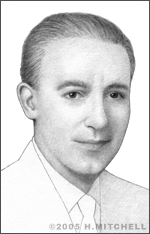
Born on Feb. 22, 1900, in Germany, Kollsman studied mechanical engineering in Stuttgart and Munich. He immigrated to the United States in 1923 and began work as a truck driver's assistant before finding a position as a mechanic for Pioneer Instrument Co., a subsidiary of Bendix, near Brooklyn, New York. Pioneer was a maker of compasses, gauges, accelerometers and other instruments for airplanes. There, Kollsman was uninspired, and so he left with dreams of building devices of his own that he could believe in. In 1928, with $500 as capital, he started his own company, Kollsman Instrument Co.
Aviation itself was in its very early days, with the Wright brothers having completed their historic flight at Kitty Hawk, N.C. in 1903. Altimeters existed that could accurately determine an airplane's height within a few hundred feet, and this was fine for good light and perfect weather, but it made flying at night or among clouds or fog virtually impossible. Kollsman knew an altimeter that responded to changes in barometric pressure could change all that, and his 1928 invention measured air pressure and determined altitude with accuracy within just a couple of feet.
It was a struggle to get anyone to take his device seriously at first. Then aviator James "Jimmy" Doolittle agreed to try Kollsman's altimeter on an historic flight on Sept. 24, 1929. Employing Kollsman's altimeter in combination with a gyroscopic, artificial horizon gauge invented by Lawrence Sperry, a ground-based radio navigation system for communicating the aircraft's position, and a cockpit navigation display built by the National Bureau of Standards, Doolittle completed the first blind flight, proving it possible to fly "by the gauges."
Before too long, Kollsman's altimeter had nearly cornered the altimeter market, and he continued to improve on these devices while creating a variety of other dashboard instruments out of his Elmhurst, N.Y. plant and Glendale, Calif. branch factory. He acquired more than 200 patents and supplied products for planes around the world in addition to technology for the U.S. military, World War II airplanes, and U.S. Apollo missions, including a sextant used on Apollo 13.
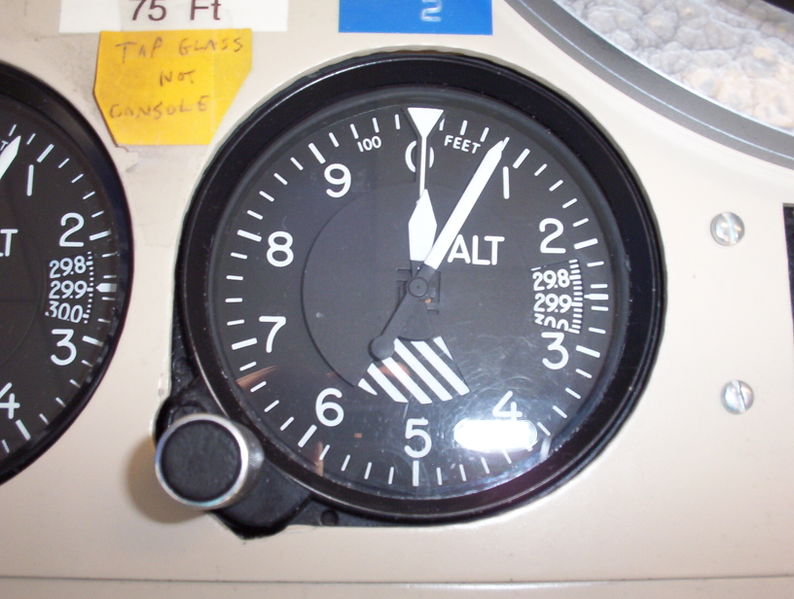
His altimeter became known as the "Kollsman Window," as it incorporated a window that allowed pilots to dial in a setting manually for calibrating barometric pressure at current sea level. To this day, pilots coming in for a landing may ask radio communications tower operators to give them their "Kollsman number," or atmospheric pressure in the area, which tells him or her whether an adjustment is needed in the plane's altimeter for accurate landing.
Kollsman died on Sept. 26, 1982. Today Kollsman, Inc. is based in Merrimack, N.H., where the company continues to develop avionics and electro-optic instrumentation, as well as aerospace equipment and defense system technology.
Source:
Inventor of the Week: Archive
And the answer to today’s quiz?
The inventor who died on this day in 1902 that developed and patented a highly popular item of clothing in 1873:
Levi Strauss
On May 20, 1873, Strauss and his business partner Jacob Davis received United States patent #139121 for using copper rivets to strengthen the pockets of denim work pants. Levi Strauss & Co. began manufacturing the first of the famous Levi's brand of jeans in San Francisco.
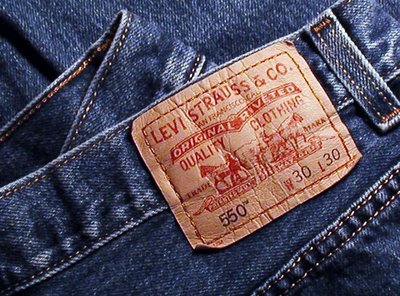
And tell the truth… how many of you are wearing a pair right now?




Comments